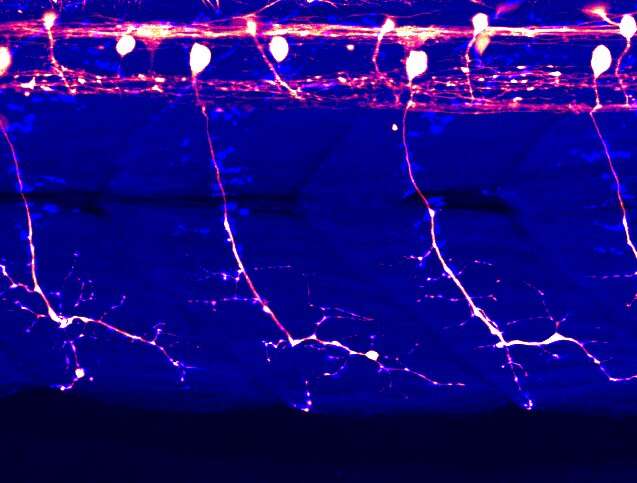ALS mystery illuminated by blue light

A joint research group in Japan has succeeded in reproducing key ALS symptoms in a small tropical fish by remotely controlling a disease-associated protein molecule using light illumination.
In amyotrophic lateral sclerosis (ALS), also known as Lou Gehrig's disease or motor neuron disease, nerve cells called motor neurons progressively degenerate. These motor neurons accumulate inclusions containing an aggregated form of TDP-43 protein.
In human body, motor neurons align along the spinal cord length and extend along the cables called axons to connect with muscles covering the body surface. This anatomical feature makes motor neurons one of the most difficult cells to observe. Consequently, we do not fully understand when and how healthy motor neurons begin to become abnormal and pathological in ALS.
In a study published last week in the journal Nature Communications, the authors devised a new TDP-43 variant by attaching human TDP-43 to a plant protein that forms protein aggregates upon absorption of blue light. This light-controlled or "optogenetic" TDP-43 functions normally as TDP-43 in the dark, but it gradually forms aggregates when illuminated by blue light. The authors focused on the motor neurons of zebrafish because they share several characteristics with human motor neurons. Whole cell can be visualized because of the transparent fish body (Figure). Employing their own original techniques, the authors expressed the optogenetic TDP-43 in zebrafish motor neurons and discovered that key ALS pathologies appeared when the fish were simply illuminated by blue light (Movie).
Unexpectedly, the connection between the motor neurons and muscles weakened even when light illumination was ceased and before the optogenetic TDP-43 was aggregated. This result suggests that motor neurons are already damaged before TDP-43 develops into typically large aggregates that are observed in the terminal phase of ALS.
Dr. Asakawa, who spearheaded this research, said, "This research, for the first time, shows that TDP-43 aggregation is a cause of motor neuron dysfunction in animals. We think that the small TDP-43 assemblies, which are called TDP-43 oligomers, might be more toxic to motor neurons than the larger aggregates."
He continued "We can now produce an ALS-like state in a temporary and spatially tuned manner by controlling light intensity and the position of illumination. Our ultimate goal over the next few years is to identify chemicals that prevent optogenetic TDP-43 from forming oligomers and aggregates, and we hope such chemicals will be used for ALS treatment."
More information: Kazuhide Asakawa et al, Optogenetic modulation of TDP-43 oligomerization accelerates ALS-related pathologies in the spinal motor neurons, Nature Communications (2020). DOI: 10.1038/s41467-020-14815-x
















